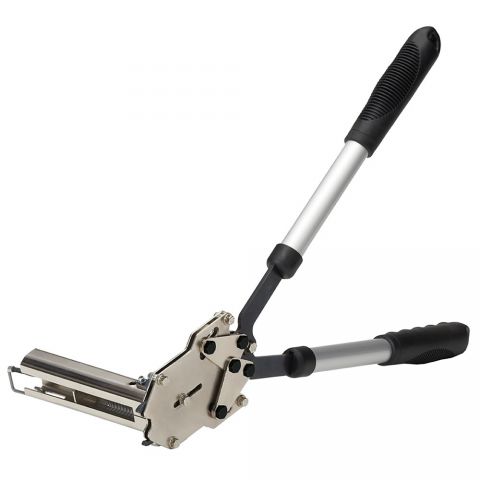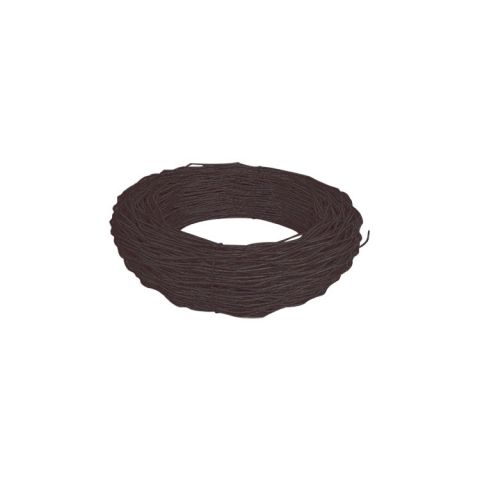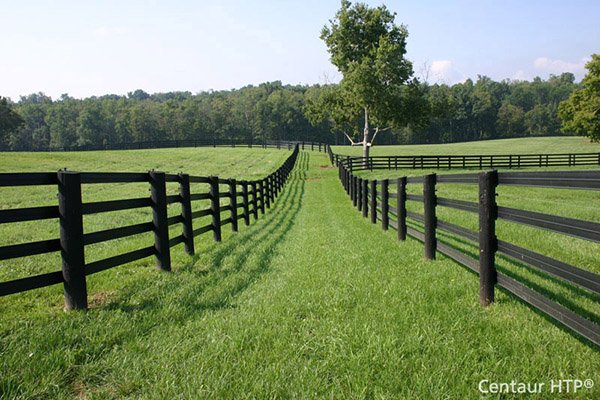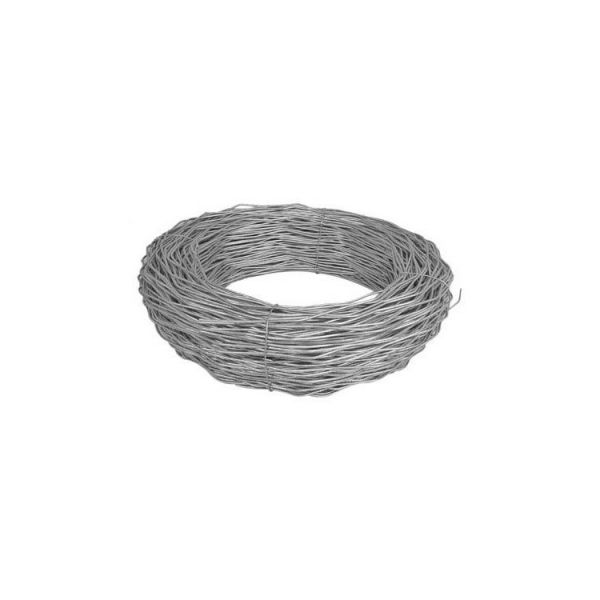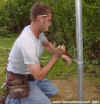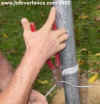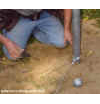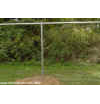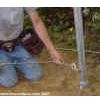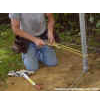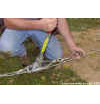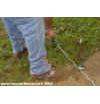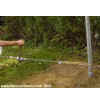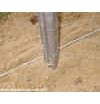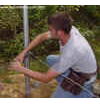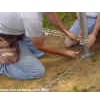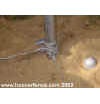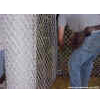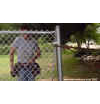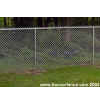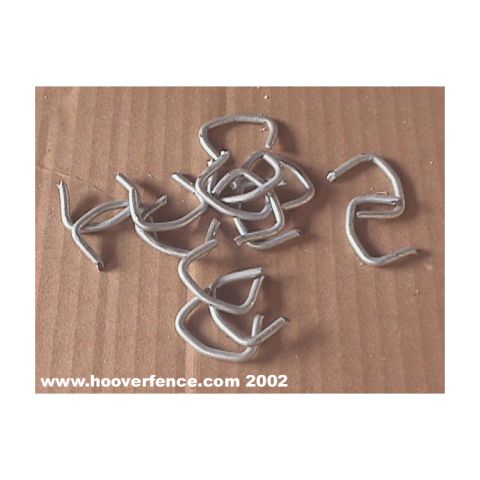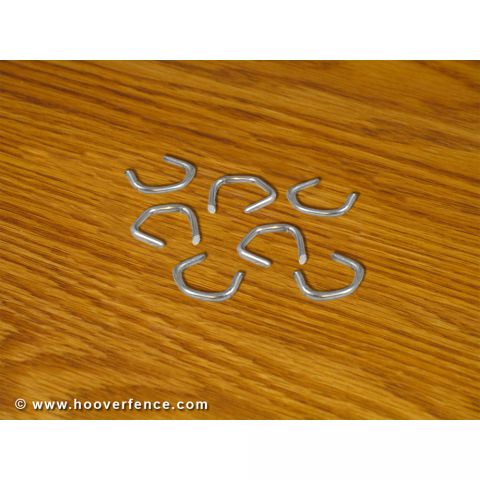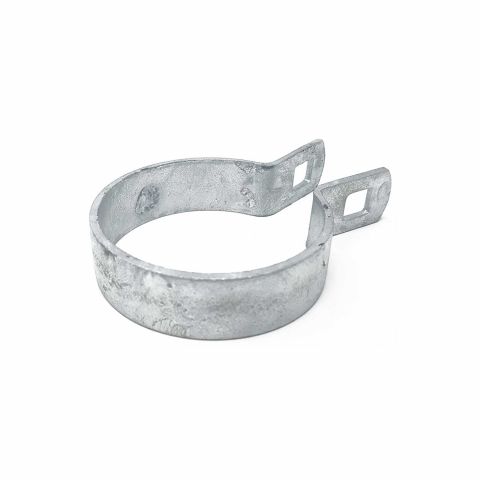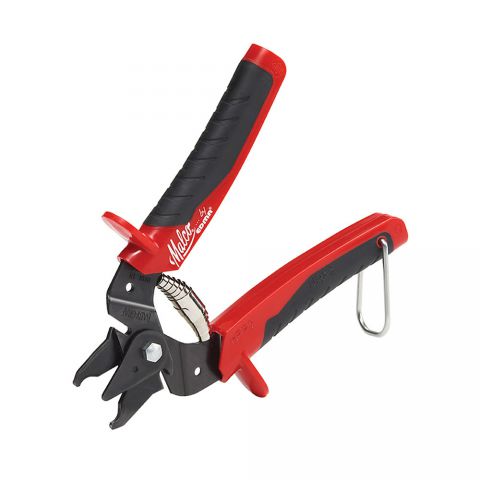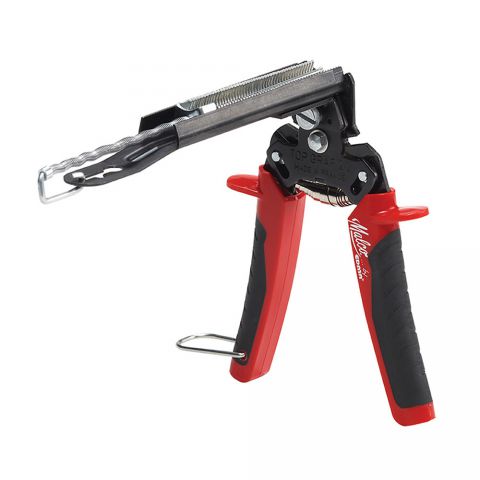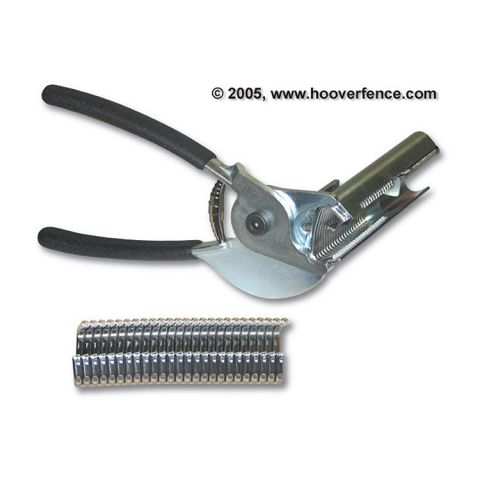Chain Link Fence Tension Wire, Galvanized, 7 Gauge
Item # CL-TENSION-WIREDetails
Details
Chain Link Fence Tension Wire, Galvanized, 7 Gauge (CL-TENSION-WIRE)
Tension wire may be used for a variety of applications. It is commonly used as a bottom tension wire on chain link fences and serves both structural and aesthetic purposes. Bottom wire helps prevent animals and people from 'pushing' their way underneath a fence. It will not prevent an animal from digging underneath a fence, however may help discourage this behavior. Tension wire may be retrofitted on to existing fences. Wire would be stretched on outside and slid up under the bottom of the fence. We recommend bottom wire on all chain link fences, especially vinyl coated chain link since it tends to be more elastic in nature. Bottom wire is also recommended on all chain link fences installed for security purposes. Tension wire is occasionally used in lieu of top rail on a chain link fence. This cuts down on costs significantly and may make the fence more difficult to climb. Be sure to brace and truss all terminal connections if tension wire is to be used in place of top rail to prevent terminal posts from 'pulling'.
Specifications
Specifications
| Length | Weight |
|---|---|
| 1' | <1 lb |
| 1,000' | 100 lbs |
Weights shown are approximate.
FAQ
FAQ
Installing tension wire tight can be a real challenge even for some experienced installers. Here are some tips that will help.
Tension wire is commonly used to stiffen the top or bottom of a chain link fence and is installed to pass at the center of the top or bottom diamond of the chain link fabric. Contrary to the belief that it somehow is woven through the diamonds, the tension wire is fastened to end, corner, stretch or gate posts (called terminal posts), usually at the same posts that the chain link fabric is stretched to, and passes continuously past the line posts without any connections at the line posts. In the case of bottom wire, the wire should be placed on the same side as the chain link between the line posts and chain link fabric. The top wire is used in place of top rail and is installed, like top rail, through the loop caps on the line posts.
Many types of wire are used for tension wire. The intended wire is usually a 7 ga. wire which comes in large coils (about 18"-24" in diameter) and is not perfectly straight. It has slight bends back and forth, called springs, that resist being pulled straight, which helps keep the wire tight after installation. 6-7 ga. tension wire usually comes in 1000' coils.
Many residential installations will require a lighter gauge, in which case, a straight wire is used without the 'springs'. We recommend a 12 1/2 ga. hi-tensile wire for this type of application. It is made to stretch, whereas most other types are difficult to keep tight and often times it will break, if over stretched. Unfortunately, most contractors do not use this type and it is difficult to find it smaller than 2000' coils (no we will not try to uncoil and measure out 115' for you - a $2.30 sale that takes half a day). You could purchase the whole coil (for about $40.00) and save the rest. You'll have a lifetime supply of utility wire for your household projects. If this is a no-go proposition, purchase a heavier regular gauge in a manageable footage.
First of all, use brace bands and bolts for the terminal post hookups. The method of wrapping the wire around the end posts is inferior and can make the installation a lot more difficult. The savings in fittings are not worth the money and the method is a no-go on most spec. jobs.
Stretch the tension wire on the same side as the chain link is to be installed and install it before the chain link. Make your first connection by making a small loop in the wire of about 1-1 1/2" or smaller so a 5/16" bolt will slide through it easily. Wrap the wire around itself tightly.
The easiest way to do this with 7 ga. wire is to hold the loop flat between large pliers very firmly. Use a helper, if available, because this may take two hands to hold it tightly. You can also pass a large heavy duty screw driver, or the handle of your pliers through the loop hole. Give yourself plenty of tail wire to work with, with the intention of cutting off the excess after wrapping. Use the hole in the handle of a crescent wrench, by sliding the tail of the wire through the hole and using the wrench to bend the wire around itself. The wrench will ride flat against the wire and as you wind it around the wire you can wrap it very tightly and neatly. The wrench will give you leverage as it lies on the wire and the end passing through the hole is pulled around the straight part of the wire. If you leave a lot of tail wire (about a foot), you can easily wrap it be hand, although not as tightly as the previous method, and cut off the excess. (Don't worry about losing the .0056 cents, it will cost you $5.00 in time fussing with the short ends). About 5-6 wraps meets most requirements. There is a way to spread your fence pliers with the loose end between them and force the end to wind tightly around itself, but unless you can picture that clearly in your mind, forget it because I don't have time to draw you a picture.
Now make the hookup by bolting the loop onto a brace band about 2-3" from the bottom of the terminal. That method is easier than grunting down in the mud at the bottom of a post trying to wrap the wire, while your pants slide down revealing your butt crack to passing traffic. Not a pleasant site regardless of your physique.
Uncoil the wire carefully as you back up the fence line to the next hookup. Make sure you are on the chain link side of the posts as you do so. Many installers prefer to have one person hold the coil at one end of the stretch while the other person pulls out the wire to the opposite end. Whichever method is used, do not let the coil unroll itself by simply laying it on the ground and pulling wire out, unless you want the worst tangle of wire you could possibly imagine. Always wrap a rope or wire around the coil before leaving it on its own. It can be like a snake, left unattended, that will self-tangle, causing the most religious to use unfavorable language.
On long stretches, use a come-a-long and wire gripper to pull the wire tight. Don't wrap the come-a-long too close to where the brace band belongs or you will be fighting for space. 6" higher than the ultimate resting place of the brace band should suffice. Use a wire or cable sling to hook the come-a-long to the terminal instead of wrapping the come-a-long around the post and hooking it to itself. Your come-a-long will last longer and you won't get those nasty splintered cable wires that always seem to find their way 1/2" or so up your fingernail. (It evens hurts to think about it doesn't it?)
After tightening, pull the slack past the terminal post and cut the wire about a foot past the post. Hold both ends of the wire before cutting. I saw the end spring back ten feet one time and knock a man's tooth out. It did not improve his appearance.
Put the other brace band and bolt into the position where it belongs. Pull the wire hand tight as hard as you can past the post with one hand and place your thumb of the other hand to mark the position where the wire and bolt in the brace band intersect. Now without losing that position bend the wire end sharply at your marking thumb so the wire makes a right angle bend. That is where the next loop has to be. You can choose to make the loop like previously with your nose out of the mud or push the end into the brace band and wrap it in its final position. On top wire I choose the later and on bottom rail, I prefer to pre-loop. Be careful not to shorten the length, if you pre-loop, but if you do, you can always crank the come-a-long a little tighter until the loop will reach the brace band. Slide the brace band bolt through the loop and tighten the bolt.
If the stretch is too short, say 10' or less, do not use a come-a-long at all. Simply hand pull it tight, make your 90 degree wire bend as described before and pre-loop the wire just a hair short. If you make the second loop a little larger, about a 2" loop, you can form the loop rounder or more oblique to reach the brace band when bolting it. If you fail to get it as tight as you would have liked, don't panic. Simply take a pair of pliers and place the jaws around the wire stretch at a 90 degree angle and with the handles spread apart twist the pliers, forcing a crimp in the wire, which will tighten it. Repeat this crimping method every 6 inches or so along the length of the stretch until the wire is tight.
Most installers over tighten the stretches with a come-a-long. Do not crank the come-a-long until it will crank no more. That is too tight assuming you are using a 1000 lb. come-a-long. If you are using the 2 ton variety with the pulley on the cable, lose the pulley. That makes it a 1 ton come-a-long. That is enough for any fence or wire stretching.
Another tip: Temporarily tie the bottom tension wire to every fifth line post or so by lifting it a couple of feet above the ground. This will get the wire out of your way for stretching the chain link and avoid the chain link bottom getting tangled in the tension wire.
After stretching the bottom tension wire release the temporary ties and hog ring the tension wire half way up on the bottom chain link diamond. Place hog rings a maximum of 2' apart or as needed securing the wire to the chain link mesh. Ideally place alternate the hog rings in such a way that one is 'squeezed' to the bottom of the diamond and the next to the top wire in the diamond. The wires I speak of are the top and bottom bottom diamond wires that intersect on the sides of that diamond. This, in effect lifts the bottom wire, when attached to a top intersecting wire, and pulls down on a bottom intersecting wire. The wire should still be straight, but it will bind it so it doesn't fall completely to the bottom of the diamond, like it would if you connected it only to bottom intersecting wires.
No tie wires are necessary to hold the tension wire to the line posts unless you are anal retentive.
Someday I'll add some much needed illustrations here, but I just got six phone calls; two customers are wondering when they are going to get a fence they bought yesterday, one customer whose fence was installed 9 years ago wonders if her warranty is still good (I'm not real sure we did the job), a truck broke down, a Bobcat has a flat over on that junk yard job that I tried to get out of but couldn't and some gal from a Tennessee fence company just called who wants to know how a gate opening size is measured (hint 'opening size' - did she use our 800 number?).
CAUTION: Wear safety glasses when handling wire - you will look kind of funny with a 1000' coil of wire hanging from your eyeball. Also use bolt cutters for cutting 7 gauge wire instead of pliers to impress your co-workers with your powerful grip, or twenty years from now you won't be able to twist the cap off a pickle jar for your wife (gee..how do I know that?)
Instructions
Instructions
Chain Link Tension Wire Installation Tutorial
Often it is easiest for one person to hold the coil of wire upright while the other 'walks' the loose end to the other end of the fence. The next step is to hook up the loose end to the terminal post using a brace band a nut and bolt. The loose end is looped through the bolt and wrapped around the wire itself (Fig. 1 & 2) When installed, the tension wire is 'sandwiched' in the brace band. Tension wire is installed on the same side of the posts as the chain link fabric (Fig. 4). Once chain link is stretched, the tension wire will be 'sandwiched' between line/ intermediate posts and the chain link fabric (Fig. 10)
Tension wire is most commonly stretched using a come-a-long and wire grip. Do not wrap the cable of the come-a-long around the post (Fig. 5). This action done repetitively will cause the cable to fray and be destroyed. Instead a 'sling' may be made of rope or cable to wrap around the stretch post (Fig. 6). Release and pull out 6-10' feet of cable from the come-along. The length of cable to pull out will depend on the length of stretch of tension wire. Hook a cable puller to the ratchet end of the come-a-long. Secure tension wire to cable puller (Fig. 7). By cranking with the handle of the come-a-long, the wire will be pulled tight (Fig. 7 & 9).
With the come-a-long cranked tight, bend the tension wire where it would loop into the nut and bolt. Next, cut 6-8" past this bend with bolt cutters. Be careful as both ends of the wire will 'whip' from the tension and can be dangerous. Fish the looped end of wire through the nut and bolt and wrap as before. Release come-a-long repeat process for other runs of fence. Note: Short lengths, approx. 12' and less, are difficult to do using a come-a-long. These are often simply done by hand. The tension wire naturally has crimps in it. With the use of pilers in their open position, these crimps can be crimped further causing the wire to tighten (Fig. 8). Be sure to crimp throughout the length for a uniform appearance.
Once tension wire is installed, the chain link fabric may be stretched. Chain link is installed to terminal posts using tension bars, tension bands, and nuts and bolts. Often one end is installed with the roll upright for ease (Fig. 14). The roll may then be laid down flat of the ground and rolled to other end. Additional rolls may be added easily and the weaving is easily done on the flat ground. Chain link is stretched with a come-a-long and spreader bar for longer stretches (20' or more). A pul-jak is used for shorter stretches (20' or less) (Fig. 15). As tension bands are installed an equal distance apart, usually the bottom brace band holding the tension wire may be adjusted so that the tension wire is centered on the bottom diamond of the fabric. The top rail, line posts are tied last. Hog rings are installed to secure the tension wire to the chain link fabric.
Reviews
Reviews
Average Customer Rating:
 (2 Reviews)
Write a Review (requires login)
(2 Reviews)
Write a Review (requires login)
This company is very knowledgeable and..helpful 
Made buying a chain link fence a breeze!
We received items quickly 
We received items quickly, but wont put fencing up until our house is built.
Shipping
Shipping
Shipping Expense Disclaimer: All orders are subject to confirmation. Additional shipping expenses, although rare, may apply due to weight, size, location, and/or other variables. Should your order require additional funds to cover the transportation of goods, you will be contacted prior to order processing for approval.
Parts for this product
You May Also Like
